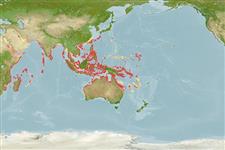>
Ovalentaria/misc (Various families in series Ovalentaria) >
Pomacentridae (Damselfishes) > Pomacentrinae
Etymology: Neoglyphidodon: Greek, para = the side of + Greek, glyphis = carved + Greek, odous = teeth.
More on author: Cuvier.
Environment: milieu / climate zone / depth range / distribution range
นิเวศวิทยา
เกี่ยวกับทะเล,น้ำเค็ม เกี่ยวกับหินโสโครก; ไม่มีการอพยพย้ายถิ่น; ระดับความลึก 1 - 12 m (Ref. 7247). Tropical; 30°N - 30°S, 34°E - 171°E
Indo-West Pacific: Red Sea and East Africa to the Indo-Malayan Archipelago, Philippines, Taiwan, Ryukyu Islands, Palau, New Guinea, Solomon Islands, Vanuatu, and northern Australia.
ขนาด / น้ำหนัก / Age
Maturity: Lm ? range ? - ? cm
Max length : 18.0 cm TL เพศผู้/กระเทย; (Ref. 4391)
Short description
เครื่องมือที่ใช้ในการแยกชนิดสัตว์,สิ่งมีชีวิตออกจากกัน | สัณฐานวิทยา | ความยาวต่างๆ
เงี่ยงครีบหลัง (รวม) : 13; ก้านครีบอ่อนที่หาง (รวม) : 13 - 15; เงี่ยงครีบก้น: 2; ก้านครีบอ่อนที่ก้น: 12 - 15.
Adults are found in coral-rich areas of lagoon and seaward reefs and usually associated with soft corals on which it feeds (Ref. 1602, 58652). Occur singly or in pairs (Ref. 1602). Juveniles are encountered in around staghorn Acropora corals (Ref. 1602). Adults often near Tridacna clams and may feed on their feces (Ref. 9710). Oviparous, distinct pairing during breeding (Ref. 205). Eggs are demersal and adhere to the substrate (Ref. 205). Males guard and aerate the eggs (Ref. 205). Diurnal species (Ref. 113699).
Life cycle and mating behavior
วัยเจริญพันธุ์ | การสืบพันธุ์ | การวางไข่ | เซลสืบพันธ์ของเพศเมีย(ไข่) | ความดกของไข่ | ตัวอ่อน
Oviparous, distinct pairing during breeding (Ref. 205). Eggs are demersal and adhere to the substrate (Ref. 205). Males guard and aerate the eggs (Ref. 205).
Allen, G.R., 1991. Damselfishes of the world. Mergus Publishers, Melle, Germany. 271 p. (Ref. 7247)
IUCN Red List Status (Ref. 130435: Version 2024-2)
Threat to humans
Harmless
Human uses
การประมง: ไม่มีผลประโยชน์; สถานที่แสดงสัตว์และพืชน้ำ: สถานแสดงสัตว์น้ำของรัฐ
เครื่องมือ
Special reports
Download XML
แหล่งที่มาจากอินเตอร์เน็ต
Estimates based on models
Preferred temperature (Ref.
123201): 25.1 - 29.3, mean 28.4 °C (based on 2528 cells).
Phylogenetic diversity index (Ref.
82804): PD
50 = 0.5020 [Uniqueness, from 0.5 = low to 2.0 = high].
Bayesian length-weight: a=0.02344 (0.01134 - 0.04848), b=2.98 (2.80 - 3.16), in cm total length, based on LWR estimates for this (Sub)family-body shape (Ref.
93245).
ระดับชั้นอาหาร (Ref.
69278): 3.4 ±0.4 se; based on diet studies.
ความสามารถในการกลับคืนสู่ปกติ (Ref.
120179): ขนาดกลาง, เวลาต่ำสุดที่จะทำให้ประชากรเพิ่มขึ้นเป็น 2 เท่าใช้เวลา 1.4 - 4.4 ปี (Preliminary K or Fecundity.).
Fishing Vulnerability (Ref.
59153): Low vulnerability (10 of 100).
Nutrients (Ref.
124155): Calcium = 78 [41, 124] mg/100g; Iron = 0.635 [0.375, 1.017] mg/100g; Protein = 18.6 [17.5, 19.7] %; Omega3 = 0.104 [0.064, 0.166] g/100g; Selenium = 20.7 [11.9, 38.7] μg/100g; VitaminA = 86 [26, 269] μg/100g; Zinc = 1.35 [0.92, 1.96] mg/100g (wet weight);
